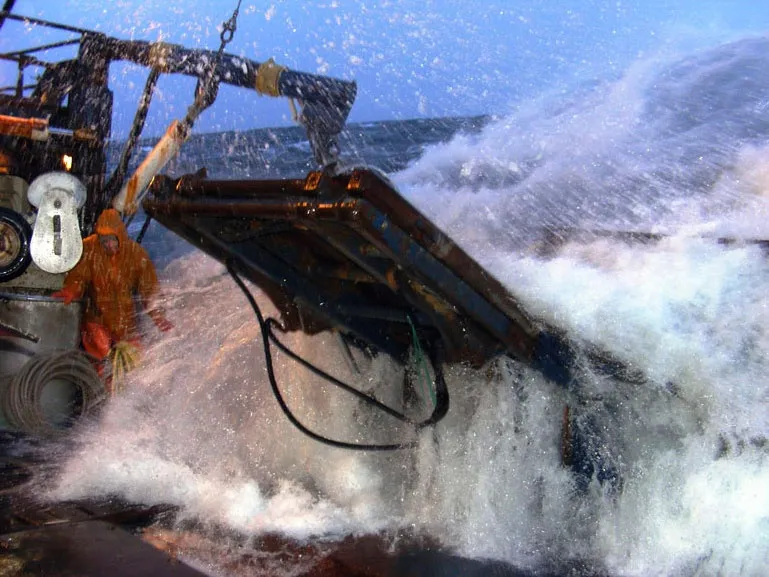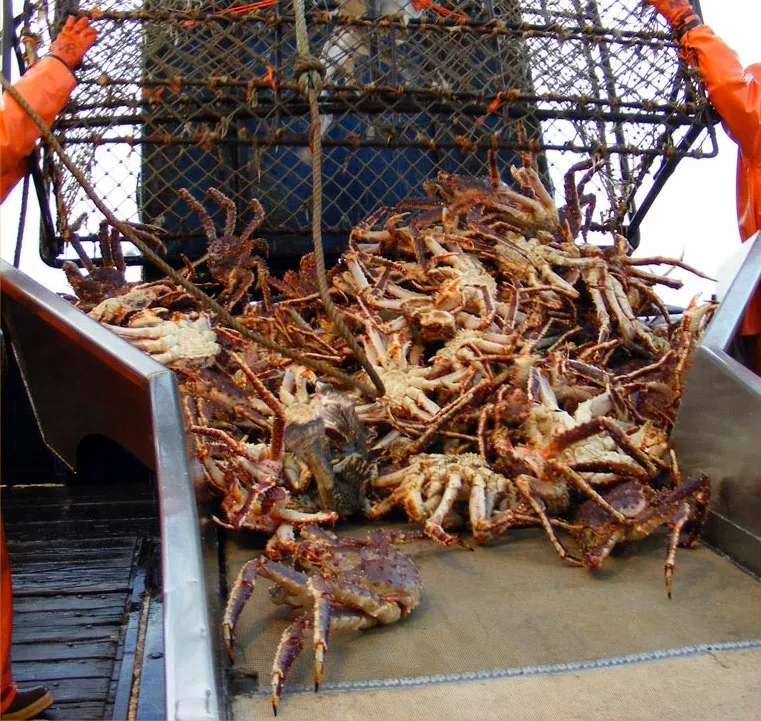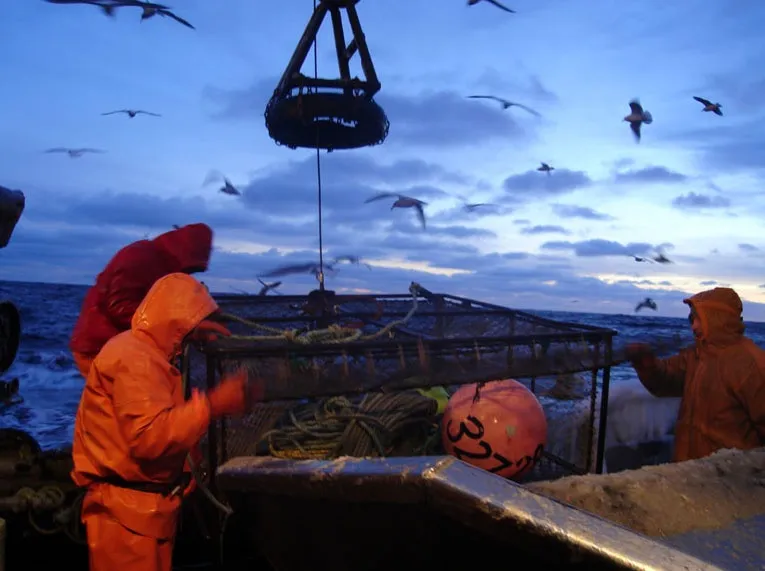Alaska, a land of wonders and harshness, is renowned not only for its majestic natural landscapes but also as the habitat of the giant king crab, a seafood delicacy sought after worldwide. Every autumn, as the first cold winds arrive, Alaskan fishermen embark on a challenging journey to conquer this precious seafood in the icy Bering Sea. King crab fishing is not just a livelihood; it’s a battle against nature, where courage and perseverance are forged through each fierce wave.
The Legend of Alaskan King Crab: “White Gold” from the Deep Sea
Alaskan king crab, while not the largest crab species globally, still boasts a size that amazes anyone. With a leg span reaching up to 1.8 meters and an average weight of 6 to 10kg, these giant crabs are truly “monsters” of the deep sea. They inhabit the frigid waters near the Arctic, where depths can reach 400 meters, appearing only in autumn and early winter, creating a short but vibrant fishing season.
Alaskan king crab is not only famous for its size but also for its sweet, firm meat, distinctly different from other crab species. This is why they are dubbed “white gold” of the sea, a priceless gift nature bestows upon Alaska. The global demand for king crab is constantly increasing, turning crab fishing into a key economic sector for Alaska, attracting thousands of fishermen to this arduous endeavor.
Alaskan King Crab Season: A Battle Against Mother Nature
The king crab fishing season in Alaska typically begins around October and lasts until January or February of the following year. This is when the Bering Sea becomes most severe, with fierce blizzards, large waves, and temperatures that can drop below freezing. However, it is in these harsh weather conditions that king crabs are most active and concentrated in certain sea areas, creating opportunities for fishermen to catch them.
The Alaskan authorities impose strict regulations on the fishing season and the number of crabs allowed to be caught to conserve this precious seafood resource. Limiting the season makes fishing time extremely valuable; fishermen must seize every hour, every minute to go out to sea, regardless of difficulties and dangers. They understand that this is not only a chance to earn a living but also a responsibility for the future of this traditional occupation.
Secrets of Giant King Crab Fishing: From Crab Pots to Fishermen’s Grit
To catch giant king crabs in Alaska, fishermen use a special tool called a crab pot. These pots are usually made of steel, round or square, quite large and weighing up to hundreds of kilograms. Inside the pot, bait, usually herring or cod, is placed to attract crabs.
| Steel crab pot used for Alaskan king crab fishing, baited to attract crabs. |
The king crab fishing process begins with dropping the pots into the sea. Fishermen must determine the pot placement based on experience and modern positioning equipment to ensure the pots land in areas where crabs live. After dropping the pots, they must wait for a certain period, usually from a few hours to a few days, for crabs to crawl into the pot to feed.
When it’s time to retrieve the pots, a powerful winch and crane system is used to haul the heavy pots from the seabed onto the boat. This process requires smooth coordination among the crew members, as even a small mistake can endanger people and the vessel.
 Alaskan fishermen use a winch and crane system to haul heavy crab pots onto a boat in harsh weather conditions. Alaskan fishermen use a winch and crane system to haul heavy crab pots onto a boat in harsh weather conditions. |
|---|
| Alaskan fishermen use a winch and crane system to haul heavy crab pots onto a boat in harsh weather conditions. |
Once the pots are on deck, the next task is to sort the crabs. According to regulations, only mature male crabs of a certain size are allowed to be kept, while small crabs or female crabs must be released back into the sea to preserve the breeding stock. This is a strict procedure, reflecting Alaskan fishermen’s respect for nature and the sustainability of their profession.
 Alaskan fishermen carefully sort king crabs, keeping only those that meet standards and releasing undersized ones back into the sea. Alaskan fishermen carefully sort king crabs, keeping only those that meet standards and releasing undersized ones back into the sea. |
|---|
| Alaskan fishermen carefully sort king crabs, keeping only those that meet standards and releasing undersized ones back into the sea. |
Harsh Challenges: Facing the Raging Sea
King crab fishing in Alaska is not only a laborious job but also fraught with dangers. Fishermen must face harsh weather, rough seas, and the ever-present risk of accidents. Large waves can crash onto the deck at any time, sweeping away everything and threatening lives.
| Large waves and ice cover the deck of an Alaskan king crab fishing boat, creating a dangerous working environment. |
Ice is one of the biggest challenges for fishermen. Seawater freezes on the ship’s hull, on machinery, even sticking to fishermen’s clothes, making all operations more difficult and dangerous. They often have to break ice to ensure the boat is not overloaded and equipment functions normally.
| Alaskan fishermen break ice off the side of their boat to ensure safety and maintain vessel operations in icy conditions. |
Although king crab fishing is supported by modern mechanized means, the role of humans is still crucial. Courage, health, experience, and teamwork are key factors determining the success and safety of each sea voyage. Alaskan fishermen are not just laborers but also true warriors, ready to face all challenges to conquer the sea.
 Alaskan fishermen work tirelessly on deck, demonstrating courage and extraordinary work ethic. Alaskan fishermen work tirelessly on deck, demonstrating courage and extraordinary work ethic. |
|---|
| Alaskan fishermen work tirelessly on deck, demonstrating courage and extraordinary work ethic. |
Alaskan King Crab: A Priceless Delicacy on the Table
After days at sea, facing countless hardships and dangers, the result that Alaskan fishermen bring back are batches of fresh, delicious, and high-quality king crab. Alaskan king crab is not only an important source of income for fishermen but also a world-famous culinary specialty.
King crab meat is white, firm, and sweet, containing the distinctive flavor of the sea. They can be prepared into many attractive dishes such as steamed crab, grilled crab, crab hotpot, crab soup, crab salad, or simply boiled or steamed and dipped in salt, pepper, and lemon to fully appreciate the wonderful taste.
| Alaskan King Crab, a prized seafood delicacy with sweet, firm meat and distinctive flavor. |
Not only a delicious dish, Alaskan king crab is also rich in nutrients, good for health. They are a rich source of protein, vitamins, and minerals, especially omega-3, which is very good for the heart and brain.
Conclusion: Discover Alaska and Experience King Crab Fishing
Giant king crab fishing in Alaska is a challenging journey that requires courage, perseverance, and grit from the fishermen. Behind each plate of delicious king crab on the dining table is a story of sacrifice, sweat, and tears of brave people who dare to confront harsh nature.
If you are someone who loves to explore and experience new things, come to Alaska in the autumn and winter to witness firsthand the life of king crab fishermen, to feel the harshness of nature, and to enjoy the wonderful taste of the sea’s “white gold.” Surely, it will be an unforgettable journey in your life.